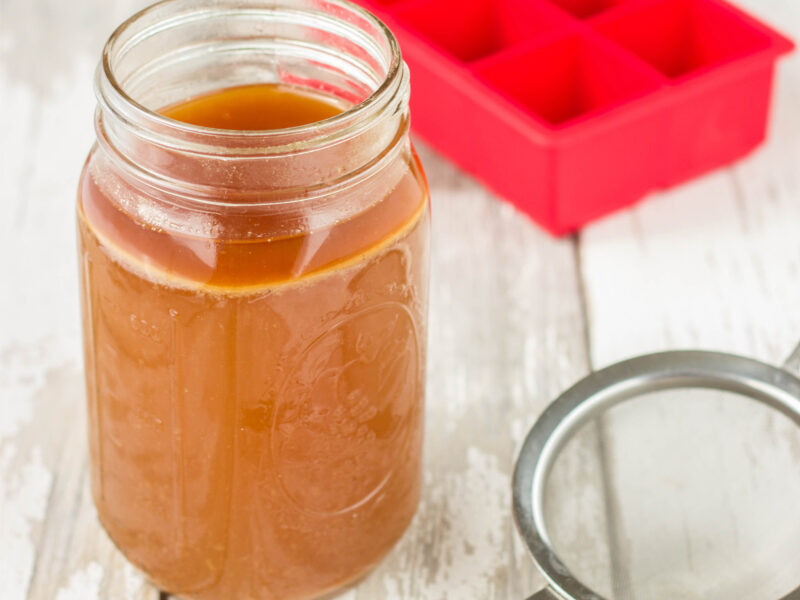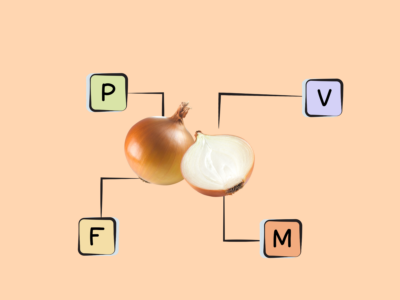Long-Simmered Chicken Bone Broth is one of the richest sources of collagen protein, which is why it’s a foundational food for a nutrient-dense diet! Most studies show measurable health benefits of collagen in doses between 10 and 20 grams daily, which is equivalent to about 1/2 to 1 cup of good quality bone broth per day. However, you can consume quite a lot more. For example, if you’re aiming for 150 grams of protein daily, you can safely get a little over 50 grams of that from collagen! I make big batches of long-simmered broth. Whatever I’m not going to use right away I freeze in wide-mouth mason jars, which makes it convenient for future use. Not only can you sip a mug of broth if you are under the weather, you can add broth to all kinds of recipes. Of course that includes, soups and stews, but also rice, mashed veggies, stir fries, hashes, and braises. You can also get super creative. Try adding broth to a smoothie, mixing it with juice or whole fruit puree for popsicles, or replacing the milk or water in a muffin recipe with broth (you’ll want unseasoned broth for all of these applications).
Add this recipe to your meal plan this week with Real Plans, the official Nutrivore meal planning app!
Featured Ingredients
The nutritional value of celery comes from its impressive phytonutrient content as it contains large amounts of over a dozen well-studied phytonutrients, including the flavones luteolin and apigenin, known for their anticancer and anti-inflammatory properties.
Onions possess potent antimicrobial activity, protecting against various bacteria, fungi, molds and yeast. The antibacterial activity of red varieties is higher than that of yellow and white varieties!
Carrots are a top food source carotenoids, which are a diverse group of fat-soluble phytonutrients responsible for giving fruits and vegetables vibrant red, orange, and yellow pigmentation. High dietary intake of carotenoids reduces risk of cardiovascular disease, type 2 diabetes, obesity, osteoporosis, many forms of cancer, age-related macular degeneration and cataracts.

Long-Simmered Chicken Bone Broth
Ingredients
- 1 gallon chicken bones and scraps (about 2- 3 chicken or 1 turkey carcass plus necks, giblets and scraps)
- 2 medium onions quartered root to stem
- 4 medium carrots washed and cut in half (about 2 cups)
- 7 medium celery stalks washed and cut in thirds
- 7 cloves garlic
- 3 medium bay leaves
- 1 gallon water or enough to cover all the ingredients
- 1 teaspoon salt
- 1 tablespoon apple cider vinegar
Instructions
- Place chicken giblets and carcasses into a big stock pot. Add enough water to cover the bones (approximately 1 gallon) and the apple cider vinegar.
- Cover and bring to a boil on top of the stove, then turn down the heat to keep a low simmer for 24-48 hours. Stir once or twice in the first few hours, and then stir at least a couple of times over the next couple of days.
- Add the vegetables, garlic, salt and bay leaves to the pot. Increase heat to bring back up to a boil, then cover and reduce heat to maintain a simmer.
- Cook for 4-8 hours more, stirring every hour or so. Let simmer with lid off for the last 2-3 hours.
- Strain all the ingredients by pouring bone broth from one pot to another through a colander or strainer.
- Place the pot containing the strained broth in a sink with water and ice to bring the temperature down quicker. Then pour the cooled broth into storage containers. Once cooled overnight remove and throw away fat cap.
Nutrition
Notes
- You can use raw bones or the bones from cooked meats. Save all the bones from bone-in meat cuts like roasts or whole chicken that and add them to a container in your freezer. When you enough for a full stockpot of broth, make a batch!
- If you’re using raw bones, skim any foam that forms at the top during the first twenty minutes or so (if you skip this step, the broth will be a bit more bitter, not the end of the world.)
- If you want to concentrate your broth for a higher collagen content, you can raise the heat to a rapid simmer and simmer with the lid off until your broth has reduced by half or more. Totally optional step, but worthwhile if a rich broth is the desired outcome!








Why do you recommend removing the fat cap?
The fats oxidize over the long cooking process. 🙂